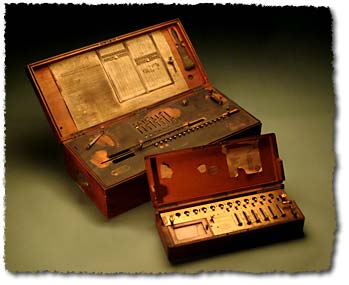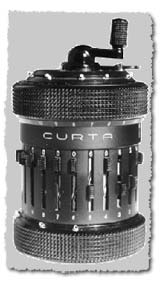Tools used for calculations
To surveyors and cartographers arithmetical calculations were necessary for the production of maps and plans. Calculations became monotonous mental drudgery and from the earliest times mathematicians tried to invent instruments and tables which could minimise their work.
The earliest form of a mathematical calculator was the abacus, developed in Babylonia around 3000 BC.
In 1614, John Napier introduced logarithmic tables whereby multiplication was reduced to addition and division to subtraction.
During the same period, men like Wilhelm Schick (1623) and Blaise Pascal (1644) built the first mechanical calculators.

By the 1890s, mechanical calculators were being used by Queensland surveyors and cartographers, but the size and weight of the machines limited their use to the office. In the field, surveyors used a set of chambers log tables.
In the 1960s, Contina Ltd of Lichtenstein produced a miniature mechanical calculator called the Curta. It was a clever and compact version of Thomas de Colmars Arithmometer, invented in 1820. Every Queensland surveyor immediately attached a Curta to his belt for use in the field. There were two models available. One provided 11 digit results and the other a more precise 15 digit output.

The Curta continued to be manufactured until about 1972. This was when the new electronic pocket calculators became available on the market. The Curta could not compete with the new technology.
The pioneer calculator, Hewlett Packard 35, replaced both the Curta and log tables as the means for calculations by surveyors and cartographers.
With the advent of computers, calculations could be fully automated via software loaded on desktop computers, portable laptops or handheld GPS units.
Related links
- Learn about Queensland’s surveying history.
- View images of instruments and equipment used to survey and map Queensland.